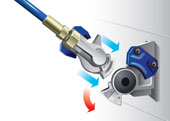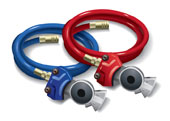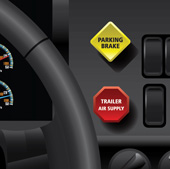Trailer Brake Subsystem
The trailer brake subsystem includes components and features on both the trailer and the truck or tractor that tows it. This chapter explains the major components of the trailer brake subsystem and how they work.
Note: There is a circuit diagram of a trailer brake subsystem here. For trailer brake components on the towing vehicle, see the circuit diagram here.
Trailer brake components
The air brake system on a trailer includes air tanks and automatic spring brake applications. Vehicles that are designed to tow trailers must be fitted with additional valves used only for the trailer. The brake system of a converter dolly that attaches one trailer to another is essentially the same as a trailer system.
Connecting a trailer
Two connections must be made to join a trailer’s brake system to the brake system of the towing vehicle. One connection carries air to fill the trailer’s tanks and is called the supply or emergency line. The other carries pressure for the service brakes and is called the service line. Two pairs of metal trailer couplers or “gladhands” are used to make these connections (See Diagram 5-1). Each coupler includes a flexible seal that provides a leak-free connection. These couplers must be kept clean and in good condition.
Most towing vehicles have receptacles called “dead end” or “dummy” couplers that protect them from dirt and water when not in use.
To connect the couplers, the surfaces that contain the seal are placed at an angle against one another. Rotating them into alignment completes the connection. Once correctly joined, the connectors lock together and considerable effort is needed to pull them apart.
Since there are two air lines to the trailer, and the design of the supply and service couplers are basically the same, there is a possibility of cross-connecting the lines. In most cases, the trailer couplers are colour-coded during manufacturing - red for the supply line and blue for the service line (See Diagram 5-2). By matching these colours, the lines are properly connected. To further prevent cross-connections, most couplers are designed so that they will only fit onto the matching coupler. Some couplers, however, have no features to prevent cross-connection.

Diagram 5-1: Trailer couplers or "gladhands"
Trailer couplers or "gladhands"
When trailer lines are crossconnected, the trailer brakes will not work correctly - the spring brakes may not release, the towing vehicle may lose air and the service brakes will not function properly. It is not safe to operate a vehicle with cross-connected trailer lines.
A towing vehicle can pull more than one trailer. To connect trailers to each other, additional supply and service connectors at the rear of a trailer must be the same as those used on the towing vehicle. To prevent air loss from these lines when they are not in use, the lines are usually equipped with manual shut-off valves. Drivers must be familiar with the proper use of these vehicles before operating them.

Diagram 5-2: Flexible air lines connect the supply and service lines from the towing vehicle to the trailer.
Applying trailer service brakes
The trailer service brakes will apply whenever the brake pedal is pressed. Often, a hand valve is also fitted on the steering column or the instrument panel of the towing vehicle so the driver can apply the trailer service brakes independent of the towing vehicle’s brakes. When the hand valve and brake pedal are used at the same time, the trailer will receive the higher pressure. Using the brake pedal or hand valve sends air pressure through the trailer service line.
Trailer hand valves must never be used for parking or emergency stops.
Trailer air supply valve
The trailer supply valve is usually a push/pull type valve near the driver that supplies air to the trailer’s brake system through the supply line (See Diagram 5-3). This valve normally has a red, eight-sided knob that the driver pushes in to open and supply air to the trailer and pulls out to close or when no trailer is attached.
Failing to close the trailer supply valve when there is no trailer attached allows a large amount of air to escape from the towing vehicle’s air brake system. To prevent all of the air from being lost, the trailer supply valve is designed to close automatically. If the valve is open and air escapes or, if the trailer breaks loose from the towing vehicle, the valve closes automatically when air pressure in the trailer supply line drops to between 138 and 311 kPa (20 and 45 psi).
Because there is a large amount of air flowing out of the trailer supply line, the pressure in it will be considerably lower than the pressure in the air tanks. This means that in most cases the valve will close automatically well before the pressure displayed on the air pressure gauges reads between 138 and 311 kPa (20 and 45 psi).
In an emergency when the trailer service brakes fail, the trailer spring brakes can be applied by using the trailer supply valve.

Diagram 5-3: Trailer air supply valve
Tractor (towing vehicle) protection valve
Once the trailer supply valve closes, the tractor protection valve on the towing vehicle also closes. This prevents air loss out of the towing vehicle when there is no trailer attached. The trailer supply valve controls the tractor protection valve. When the trailer supply valve is opened to allow air to the trailer, air pressure is also directed to open the tractor protection valve and allow air to the trailer service line. When the trailer supply valve is closed, air pressure exhausts from the tractor protection valve and it closes by spring force. When the tractor protection valve is closed, air enters the valve but does not pass through it.
Automatic spring (parking and emergency) brakes
Trailer brake subsystems use both service brakes for normal braking and spring brakes for parking and emergency braking. The spring brakes must apply automatically when the air pressure in the trailer supply line drops below 414 kPa (60 psi).
The air pressure may drop due to one of the following:
- the driver parks the vehicle and closes (pulls out) the trailer supply valve; or
- the trailer supply line ruptures or becomes disconnected for some reason.
Spring brake or service brake priority
Instead of providing air pressure to both the service brakes and the spring brakes at the same time, trailer brake subsystems give priority to one or the other. This means that, in a system with “spring brake priority,” the air from the towing vehicle first fills the air tank for the spring brakes to a certain pressure before filling the air tank for the service brakes. Most manufacturers have changed the trailer spring brake valves on spring brake priority systems such that, if there is air loss to the service brakes, the spring brakes will lose sufficient air that they will begin to apply.
Trailers with service brake priority fill the service brake air tank before filling the spring brake air tank.
Trailers with spring brake priority can be towed without waiting for the service brake air tanks to fill. This means a trailer could be on the road without enough air pressure to operate its service brakes. This is not the case in a trailer with service brake priority, which ensures that enough air is available to operate the service brakes before the spring brakes can be released and the trailer can be towed.
If there is a loss of air to the trailer service brakes in a spring brake priority system, the spring brakes may remain released while no service brakes are available on the trailer. The only way to apply brakes on the trailer is to close the trailer supply valve to cause the trailer’s spring brakes to apply automatically.
Consult your employer or a qualified person to assist you in determining whether a trailer uses a spring brake or service brake priority system.
Key points to remember
- The air brake subsystem of a trailer includes air tanks and automatic spring brake application.
- Trailer couplers or "gladhands" are used to connect the air brake system of the towing vehicle to the air brake system of the trailer.
- In most cases, trailer couplers can be identified by their colour and are designed to prevent cross-connection.
- When trailer couplers are cross-connected, the trailer service and spring brakes will not function correctly.
- The trailer hand valve is used to apply the trailer service brakes independent of the towing vehicle’s brakes.
- The trailer supply valve is usually a push/pull type valve near the driver that supplies air to the trailer’s brake system through the supply line.
- The tractor protection valve prevents air loss from the towing vehicle.
- When air pressure in the trailer supply line drops below 414 kPa (60 psi), the trailer spring brakes will apply automatically.
- In an emergency when the trailer service brakes fail, the trailer spring brakes can be applied by using the trailer supply valve.
- A trailer with a spring brake priority system will allow the trailer spring brakes to release before the trailer service brakes have enough pressure to operate.